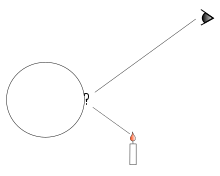Alhazen's problem
Alhazen's problem, also known as Alhazen's billiard problem, is a mathematical problem in geometrical optics first formulated by Ptolemy in 150 AD.[1] It is named for the 11th-century Arab mathematician Alhazen (Ibn al-Haytham) who presented a geometric solution in his Book of Optics. The algebraic solution involves quartic equations and was found in 1965 by Jack M. Elkin.

Geometric formulation
The problem comprises drawing lines from two points, meeting at a third point on the circumference of a circle and making equal angles with the normal at that point (specular reflection). Thus, its main application in optics is to solve the problem, "Find the point on a spherical concave mirror at which a ray of light coming from a given point must strike in order to be reflected to another point." This leads to an equation of the fourth degree.[2][1]
Alhazen's solution
Ibn al-Haytham solved the problem using conic sections and a geometric proof. He derived a formula for the sum of fourth powers, where previously only the formulas for the sums of squares and cubes had been stated.
His method can be readily generalized to find the formula for the sum of any integral powers, although he did not himself do this (perhaps because he only needed the fourth power to calculate the volume of the paraboloid he was interested in). He used his result on sums of integral powers to perform what would now be called an integration, where the formulas for the sums of integral squares and fourth powers allowed him to calculate the volume of a paraboloid.[3]
Algebraic solution
Later mathematicians such as Christiaan Huygens, James Gregory, Guillaume de l'Hôpital, Isaac Barrow, and many others, attempted to find an algebraic solution to the problem, using various methods, including analytic methods of geometry and derivation by complex numbers.[4][5][6][7][8]
An algebraic solution to the problem was finally found first in 1965 by Jack M. Elkin, an actuarian.[9] Other solutions were rediscovered later: in 1989, by Harald Riede;[10] in 1990 (submitted in 1988), by Miller and Vegh;[11] and in 1992, by John D. Smith[4] and also by Jörg Waldvogel[12]
In 1997, the Oxford mathematician Peter M. Neumann proved the theorem that there is no ruler-and-compass construction for the general solution of Alhazen's problem[13][14] (although in 1965 Elkin had already provided a counterexample to Euclidean construction).[4]
Generalization
Recently, Mitsubishi Electric Research Labs researchers solved the extension of Alhazen's problem to general rotationally symmetric quadric mirrors including hyperbolic, parabolic and elliptical mirrors.[15] They showed that the mirror reflection point can be computed by solving an eighth degree equation in the most general case. If the camera (eye) is placed on the axis of the mirror, the degree of the equation reduces to six.[16] Alhazen's problem can also be extended to multiple refractions from a spherical ball. Given a light source and a spherical ball of certain refractive index, the closest point on the spherical ball where the light is refracted to the eye of the observer can be obtained by solving a tenth degree equation.[16]
References
- Weisstein, Eric. "Alhazen's Billiard Problem". Mathworld. Retrieved 2008-09-24.
- O'Connor, John J.; Robertson, Edmund F., "Abu Ali al-Hasan ibn al-Haytham", MacTutor History of Mathematics archive, University of St Andrews.
- Victor J. Katz (1995), "Ideas of Calculus in Islam and India", Mathematics Magazine68 (3): 163–174 [165–9 & 173–4]
- Smith, John D. (1992). "The Remarkable Ibn al-Haytham". The Mathematical Gazette. 76 (475): 189–198. doi:10.2307/3620392.
- Drexler, Michael; Gander, Martin J. (1998). "Circular Billiard". SIAM Review. 40 (2): 315–323. doi:10.1137/S0036144596310872. ISSN 0036-1445.
- Fujimura, Masayo; Hariri, Parisa; Mocanu, Marcelina; Vuorinen, Matti (2018). "The Ptolemy–Alhazen Problem and Spherical Mirror Reflection". Computational Methods and Function Theory. 19 (1): 135–155. arXiv:1706.06924. doi:10.1007/s40315-018-0257-z. ISSN 1617-9447.
- Baker, Marcus (1881). "Alhazen's Problem". American Journal of Mathematics. 4 (1/4): 327. doi:10.2307/2369168. ISSN 0002-9327.
- Alperin, Roger (2002-07-18). "Mathematical Origami: Another View of Alhazen's Optical Problem". In Hull, Thomas (ed.). Origami^{3}. A K Peters/CRC Press. doi:10.1201/b15735. ISBN 978-0-429-06490-6.
- Elkin, Jack M. (1965), "A deceptively easy problem", Mathematics Teacher, 58 (3): 194–199, JSTOR 27968003
- Riede, Harald (1989), "Reflexion am Kugelspiegel. Oder: das Problem des Alhazen", Praxis der Mathematik (in German), 31 (2): 65–70
- Miller, Allen R.; Vegh, Emanuel (1990). "Computing the grazing angle of specular reflection". International Journal of Mathematical Education in Science and Technology. 21 (2): 271–274. doi:10.1080/0020739900210213. ISSN 0020-739X.
- Waldvogel, Jörg. "The Problem of the Circular Billiard.." Elemente der Mathematik 47.3 (1992): 108-113.
- Neumann, Peter M. (1998), "Reflections on Reflection in a Spherical Mirror", American Mathematical Monthly, 105 (6): 523–528, doi:10.1080/00029890.1998.12004920, JSTOR 2589403, MR 1626185
- Highfield, Roger (1 April 1997), "Don solves the last puzzle left by ancient Greeks", Electronic Telegraph, 676, archived from the original on November 23, 2004, retrieved 2008-09-24
- Agrawal, Amit; Taguchi, Yuichi; Ramalingam, Srikumar (2011), Beyond Alhazen's Problem: Analytical Projection Model for Non-Central Catadioptric Cameras with Quadric Mirrors, IEEE Conference on Computer Vision and Pattern Recognition, archived from the original on 2012-03-07
- Agrawal, Amit; Taguchi, Yuichi; Ramalingam, Srikumar (2010), Analytical Forward Projection for Axial Non-Central Dioptric and Catadioptric Cameras, European Conference on Computer Vision, archived from the original on 2012-03-07